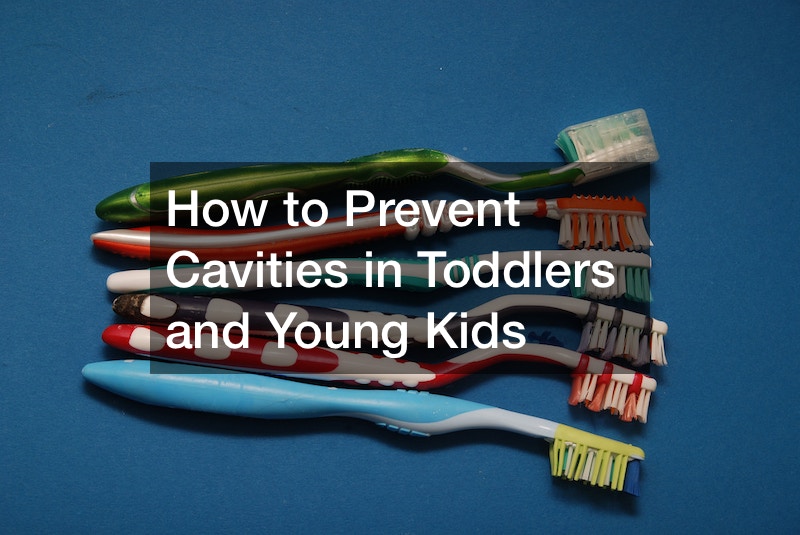

Dental health is one of the most overlooked aspects of child health care. When considering the holistic health of your kid or toddler, one of the key questions you must ask yourself is how to prevent cavities in toddlers in your care. Many people visit a family dentist with their children when the damage is irreversible or too much to ignore. Dental cavities are not just a dental problem that adults face. It affects children and toddlers. The cavity causes holes in the teeth due to decay and breakdown of the tooth enamel and is among the most common dental problem in toddlers and kids. It shows as permanently damaged areas in a tooth. If unattended, it makes the child lose the affected teeth. It is vital to keep children safe from the ravages of tooth decay. You should know the main causes to prevent the damage from the root cause. Here are some tips from a licensed family dentist.
Causes of Cavities in Toddlers and Young Kids

1. High Concentration of Bacteria
High levels of bacteria in the tooth convert the food we eat into acidic compounds that eat away the enamel causing cavities. Sugary foods and too much starch provide a conducive environment for bacteria-forming plaque. Plaque sticks to the tooth resulting in discoloration and aggravating decay. The concentration of bacteria within the mouth should be at the forefront as you work on how to prevent cavities in toddlers and young kids within your home.
2. Buildup of Plaque
Plaque is formed by food, saliva, and the acid inside the mouth. It builds up on the tooth enamel that causes holes commonly known as tooth cavities. Brushing consistently; is recommended for toddlers and kids to prevent cavities. Plaque is a major sign people often ignore that shows your children are in danger when working on how to prevent cavities in toddlers in most homes.
3. Poor Dental Hygiene and Improper Brushing
Good dental hygiene includes paying regular visits to a pediatric dentist every six months with your toddlers. Schedule a meeting with a dental specialist immediately after your child’s first tooth appears. Children generally fail to brush their teeth properly, and an adult should supervise them. They can also forget to brush. The lack of brushing then causes a plaque buildup resulting in tooth decay. Incorrect flossing or complete lack of it leads to a buildup of food particles between the teeth. It creates the right environment for plaque-causing bacteria that lead to tooth cavities. Maintaining proper dental hygiene should be the first step before you ask how to prevent cavities in toddlers and young kids within your home.
4. Improper and Imbalanced Diet
Diet is the most assumed aspect of dental health. It hugely determines the risk of exposure to tooth decay in children and adults. Eating a lot of sweet, sugary, and starchy food exposes kids to a higher risk of tooth decay.
5. Genetically Triggered Causes
Genetics has been noted to cause dental problems, specifically cavities. It needs conclusive research to confirm. Several people are known to have genetically softer enamels. It makes them prone to having tooth cavities. A dental specialist is the best person who can confirm this. Doctors examine the family-medical history to decide if the decay is genetically-caused. Genes may provide the all-important answer to how to prevent cavities in toddlers before you look for other options.
6. The Fluoride Content in Water
Water that has limited or no fluoride also causes teeth weakening. Lack of fluoride in water weakens enamel. It makes kids susceptible to tooth cavities and holds the key to your answer when you ask yourself how to prevent cavities in toddlers and young kids at home.
7. Saliva Flow
People with less than normal saliva flow are also most likely to have tooth decay problems. It creates a balanced environment within the mouth and controls acidity that majorly causes plaque and cavities.
Main Symptoms of Tooth Cavities in Toddlers and Young Kids
There are universal signs and symptoms of decay and cavities. They vary in degree for each child, but you will always identify them if you are keen on their dental health.
1. The Appearance of White Spots
They are a common symptom that indicates the enamel is breaking down or damaged to a certain degree. Spots cause sensitivity as the tooth cavities compromise the health of your tooth.
2. The Appearance of Early Cavities
A noticeable light brown cavity will appear on the tooth, which turns dark brown and later black as the cavity becomes bigger.
3. Sensitivity
Cavities cause sensitivity to certain foods and temperature changes. The affected tooth reacts to sugary foods such as sweets and hot or cold drinks. It is because the holes expose the nerve endings of the tooth leading to the reactions.
4. Pain
Tooth cavities will cause pain in the area around the tooth. It may be mild or strong depending on the degree of tooth damage. The intensity may also increase or reduce depending on the type of food. A toddler may experience pain when taking certain solid foods or either hot or cold food that they did not have in the past. Take your child to the dentist when you notice these reactions as you consider how to prevent cavities in toddlers and young kids within your household.
5. Refusal to Eat
A kid may refuse to eat when having tooth cavities because of the discomfort. Food gets into the cavities and presses the gum resulting in pain.
Diagnosis of tooth cavities in toddlers and young kids
Are you wondering about; how to prevent cavities in toddlers and young kids within your home? Diagnosis is vital in treating and preventing cavities in toddlers and young kids. During the dental visit, the specialist will come up with a diagnosis after finding out a complete history of your child, examining the mouth, and in extreme cases doing dental x-rays. Dental health is vital for your child; therefore, ensure that you have the right diagnosis at all times, even if you think all your child needs is teeth cleaning services for his cavity problems.
Prevention of Tooth Cavities in Toddlers and Young Kids

Prevention is the best arsenal when choosing how to prevent cavities in toddlers and young kids, and here is what to do
1. Brushing
Children will forget to brush their teeth or do it incorrectly. Ensure that your kid brushes at least twice a day and monitor them closely as they do so, even if it feels like you are policing them. Teach them the correct brushing technique. For toddlers, use the correct oral care solutions because their mouths also have bacteria and germs. Use soft cloth pea-sized kid-friendly fluoride toothpaste twice daily instead of a toothbrush after meals.
2. Flossing
Your child should floss their teeth at least once daily. Flossing removes food particles between the teeth. Ensure that they use the correct flossing technique. For good results, the kids should floss before brushing. Flossing should start immediately after the age of 2. This simple yet, most ignored exercise will save you from costly dental implants you may have to do in the future due to cavities.
3. Diet
A balanced diet is a sure guarantee for healthy teeth in kids. To save yourself from the high costs of dental treatment, limit sticky snacks and excessively sugary foods from the diet. Consider using healthier alternatives like yogurt, frozen banana, or dried fruits without added sugar if your kids have a sweet tooth. If your toddler uses a bedtime bottle, use plain water instead of sugary juice and formula that aggravate tooth decay.
4. Watch out for bacteria transfer to your toddler or kid
Bacteria are the main cause of acidity in the mouth. The acidity results in the accumulation of plaque that leads to tooth decay. Avoid cleaning the pacifier with your saliva to prevent the transfer of harmful bacteria from your mouth to the child. Besides transferred bacteria, limit sugary foods and monitor flossing and brushing to remove all food particles that bacteria break down into harmful acids that cause cavities. Do not ignore the role of bacteria in causing cavities when you are looking at how to prevent cavities in toddlers and young kids within your home.
5. Consider adding fluoride supplements in the diet
Fluoride in water is an important component in dentistry but may lack in some places. Consult your dental specialist for the right supplements if the water in your area lacks fluoride. You can also inquire about dental sealants or fluoride varnish from a specialist in cosmetic dentistry to deal with fluoride deficiency.
6. Schedule dental visits
Sometimes, how to prevent cavities in toddlers when you have done all the right things, but the cavities are not going away, is to go to the experts in dentistry. Your child gets the right teeth cleaning therapy and diagnosis for their problem.
7. Treatment
Treatment is the last preventive intervention for tooth cavities. Do it before it is too late. Going for treatment will prevent further damage and protect your child from tooth loss. During treatment, the decayed parts of the tooth are removed and replaced with a cosmetic filling after a thorough cleaning.
Treatment of Tooth Cavities in Toddlers and Young Kids

You should consider treatment as an option when looking at; how to prevent cavities in toddlers when taking care of their dental health. It will vary depending on the symptoms, age, the severity of the condition, and the health of your child.
In most scenarios, part of the decayed tooth will be removed and replaced with an enamel filling. The procedure is known as restoration. There are three different types of fillings for treating tooth cavities.
Indirect restorations
They involve two or more visits and include inlays, on-lays, using crowns, veneers, and crowns. Materials made from gold and metal alloys or ceramics and composites that look similar to natural tooth enamel; are used during the procedure. It is among the recommended options you should go for when looking for how to prevent cavities in toddlers and young kids medically.
Direct restorations
They are done in a single visit to the dentists. A filling is placed directly in an identified hole in the tooth that matches the natural color of the tooth. The materials commonly used for fillings are silver, resin, acrylic acids, and silver and fine glass powders.
Filling is done for toddlers and kids with more than one cavity. They work for both permanent and baby teeth involving a procedure that removes the tooth cavity and fills the resultant hole with a white composite or metallic material. It saves and preserves the condition of the tooth. In severe cases, the dentist will recommend a dental crown or extraction.
Extraction for young children can be challenging. The specialist uses laughing gas to relax the kids or an injection to numb the gums for bigger kids. General anesthesia to make the children sleep if they are very young or have multiple cavities or if they cannot stay still. Treatment may require several appointments for multiple cavities for proper treatment and monitoring.
Key Takeaways

Cavities are a problem for adults, kids, and toddlers. It is vital to look for and recognize the symptoms of a cavity in your child. You should identify them immediately and intervene to save the tooth. Diet is vital in maintaining healthy teeth in children. Sugary foods cause decay.
Proper dental hygiene alongside diet is the best way to protect your kid and toddler from cavities. If you notice problems, you should seek a proper diagnosis from a specialist and commence the right treatment to remove the decayed part of the tooth and fill it. It can make a difference when working on how to prevent cavities in toddlers and young kids without much cost or inconvenience.


